The sounds and songs of Iceland's melting landscape
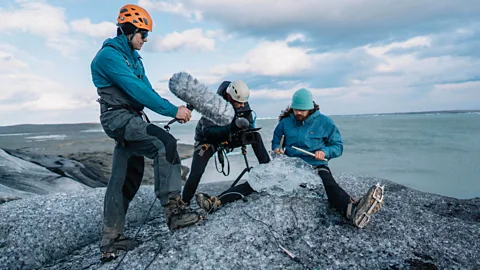 Marcus Neudigate
Marcus NeudigateKonstantine Vlasis never imagined that a single track on a Sigur Rós album would lead him to study the melting glaciers of Iceland. But a decade after first hearing the band's 2013 track Lækurinn ("The Stream"), Vlasis found himself on Iceland's highest peaks, recording the sounds of trickling meltwater and cracking ice for a PhD on the sonic life of glaciers.
As climate change accelerates glacial melt worldwide, Iceland's glaciers – which cover 10% of the country – are disappearing fast. Scientists estimate they could lose half their volume by 2100. For future generations, they may survive only as small ice caps on the tallest mountains – which is why the UN has declared 2025 the year of glacier preservation.
Vlasis hopes that sound can help people understand this environmental shift in a new way.
"Sound can teach us a lot about glaciers," he explained. "You can't see glacial movement in real time, but you can hear it."
As a percussionist trained in the concept of soundscapes – which brings together the ideas of sound plus landscape – Vlasis approaches climate communication through listening. His PhD, supported by New York University and the Leifur Eiríksson Foundation, explores how the sounds of glaciers can reveal what we might miss with our eyes alone. With more than 2.3 million travellers visiting Iceland each year to see the country's breathtaking glacial landscapes, the potential impact of his work extends far beyond the scientific community.
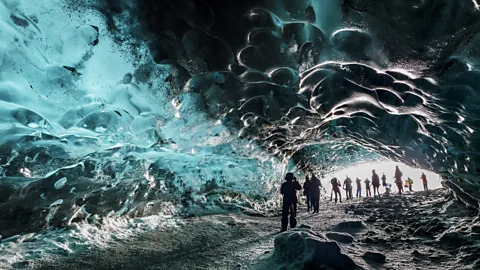 Getty Images
Getty ImagesThe track that sparked his initial curiosity is part of an album called Rímur, which features traditional Icelandic folk songs. Vlasis was intrigued that the song's only accompaniment was the sound of a stream. He listened to the lyrics' metaphor about growing older and returning home, then began to wonder: "What is this stream that I'm hearing?" When you trace the source of stream systems in Iceland, many are fed from glaciers. "What happens when the stream isn't a metaphor but it's this direct reflection of frozen ice into liquid water?" he asked.
Learn more:
Listen to Konstantine's performance piece recorded atop Breiðamerkurjökull glacier. His work can be found on www.konvlasis.com and you can follow his adventures in Iceland on Instagram @konvlasis.
His curiosity became a mission: to trace both literal and metaphorical streams, from melting glaciers to traditional songs. In Iceland, this meant travelling across the country, climbing glaciers with microphones to capture ambient sound and speaking with locals to understand how glacial landscapes have shaped Icelandic culture. Through each excursion, he's collecting a record of sound and story that may soon disappear.
Vlasis calls this the "human ecology" of glaciers: a way of understanding not only ice, but how people interact with it. Nature isn't something separate from us, he says. "We are shaping and impacting in a lot of different ways".
By amplifying the sounds of glaciers, he hopes to develop a way of listening to global warming in real time. "We look towards melting glaciers as visual symbols of climate change. I wanted to know the stories that those sounds told, and I wanted to know how people had listened to glaciers throughout history."
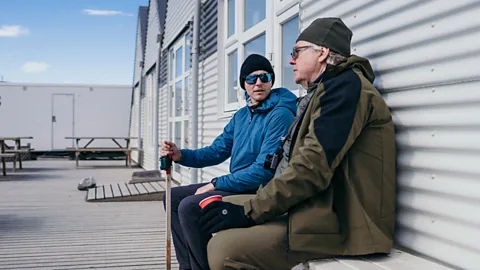 Marcus Neudigate
Marcus NeudigateSo how do you listen to a glacier? Every movement that a glacier makes creates a sound, says Vlasis. A glacier flows down a slope under its own weight, and cracks and rumbles can be heard as the ice shifts and moves. "It has rhythm, it has tempo, it has dynamics," he enthuses.
"In glacial ice there are bubbles that are almost like an archive, with their memory of past atmospheric composition. And when that ice melts, you can hear the air bubbles popping and fizzing and squealing as they melt into the water and the pro-glacial lakes."
Recording them is another challenge. Vlasis goes out on the ice around once a month to add to his library of sounds, using shotgun and omnidirectional microphones. Some he leaves out there for months at a time.
Glaciers also emit infrasound – frequencies too low for human ears. Vlasis records these using a special contact microphone that attaches directly to the ice, then raises the pitch to make them audible. "It feels almost like a stethoscope," he says, "as if I'm listening to the health of the landscape."
The second strand of his research focuses on Iceland's rímur: traditional narrative songs or poems passed down through generations. Some contain detailed references to weather patterns, floods and natural disasters. By analysing their lyrics, Vlasis extracts what he calls "environmental archives" – oral records of how people experienced glaciers over time. In the absence of written records, these songs become a vital part of understanding local histories of environmental change.
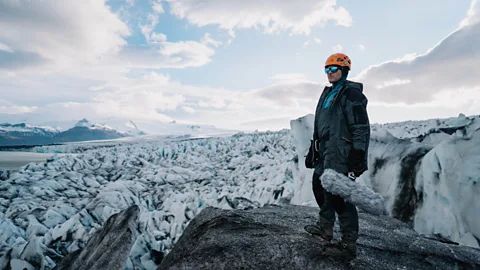 Marcus Neudigate
Marcus NeudigateHe is also working with a team of scientists who are creating predictive models of Iceland’s glacier loss over the next century. Through this art-science collaboration, Vlasis has curated a performance piece called 2124, which is a sonic rendering of this data. Poignantly played by a single drummer atop the Breiðamerkurjökull glacier, the piece is centred around a repeated rhythmic pattern, representing one year of time. It gradually speeds up, giving a sense of just how quickly the glaciers will change over the next century. The result is both beautiful and haunting: a musical forecast of a world without glaciers.
How to visit Iceland’s most impressive glaciers
The most-visited glaciers in Iceland include Breiðamerkurjökull, Fjallsjökull, Skaftafellsjökull and Sólheimajökull, all located along the south coast. Many tour companies travel to these glaciers and depart daily from Reykjavik. When visiting a glacier, make sure to do so responsibly: always join an organised group or private tour accompanied by a qualified guide and most of all leave no trace.
"As the glacier melts, you'll hear the meltwater streams enter into the foreground until you're all the way beneath the ice in an ice cave," said Vlasis. "And then you're drawn back to the surface very quickly in the final push of the piece."
Vlasis is a recent recipient of the 2024 Fulbright-National Geographic Award, which will support the creation of his next project: When Glaciers Sing. This immersive audio story, which blends field recordings, traditional songs and data sonification will be released online through streaming platforms in spring 2026.
More like this:
• How the songs of icebergs reverberate around the world
• The UN has declared 2025 as the year of glacier preservation. Here's how to visit one safely
• Elizabeth Rush on her epic journey to Earth's 'doomsday glacier'
Vlasis hopes that his research will highlight the urgency of tackling climate change, and that his unique audio documentation of Iceland's frozen landscapes will help raise awareness of glacial melt. "At the very least, songs and music can help us to bear witness to what's happening right now. Music can create meaning for us, and it can help teach us about the past."
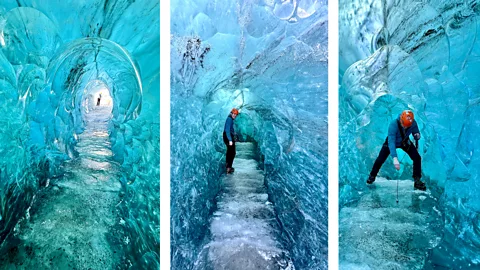 Dr Þorvarður Árnason
Dr Þorvarður ÁrnasonHe refers to a beloved Icelandic lullaby called Sofðu Unga Ástin Mín (Sleep, My Young Love), which contains the line: "In the glacier cracks scream as deep as death".
"When the song was written in 1911, glaciers still had a legacy as destructive, menacing landscapes to a lot of Icelanders. It starts to have a different meaning when we recognise how quickly Iceland's glaciers are disappearing. Will there be a time in the future where we mention glaciers and our children won't know what that is?"
And while travel can contribute to climate change, Vlasis believes responsible tourism can play an important role. "Any choice we make is tied to some sort of environmental footprint. But if you do visit a glacier, there is a great opportunity to really understand what you're visiting and what's happening to these landscapes. At the very least, I think showing some form of respect to that space is something to reflect on."
Vlasis says that based on current data, most outlet glaciers in Iceland are projected to lose their glacial classification within the next 200 years.
"If we want to live in a world without ice, we can keep doing what we're doing collectively as an industrial society. But I think glaciers can teach us how to listen. And to be able to listen well, you have to surrender your own perspectives and your own biases and be open to something new."
He adds: "I'm learning to listen better, and glaciers are certainly helping me do that."
And it all started with the trickle of one stream.
--
If you liked this story, sign up for The Essential List newsletter – a handpicked selection of features, videos and can't-miss news, delivered to your inbox twice a week.
